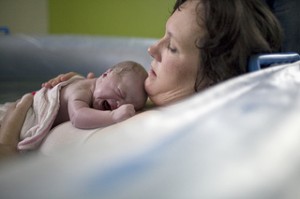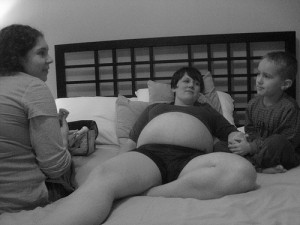Planned Home VBAC in the United States, 2004-2009: Interview with Study Author Melissa Cheyney, PhD
By: Sharon Muza, BS, LCCE, FACCE, CD/BDT(DONA), CLE | 0 Comments

http://www.flickr.com/photos/eyeliam/7353095052/
"Planned Home VBAC in the United States, 2004-2009: Outcomes, Maternity Care Practices, and Implications for Shared Decision Making" came out on August 26th as an e-pub ahead of print in the journal Birth: Issues in Perinatal Care. It provides a much-needed analysis of VBACs in the home setting in the United States. To help the birth professional community better communicate the findings with students, clients and others considering home birth after cesarean (HBAC), Jeanette McCulloch of BirthSwell interviewed Melissa "Missy" Cheyney, PhD, CPM, LDM, one of the paper's authors. The abstract of the paper, lead-authored by Kim Cox, CNM, PhD and co-authored by Marit Bovbjerg PhD, MS and Lawrence M. Leeman MD, MPH, can be found in an online-only version here. Additional insights specifically for midwives can be found at the MANA blog. - Sharon Muza, Community Manager, Science & Sensibility
Jeanette McCulloch: Tell me about the new study looking at outcomes for families planning a trial of labor after cesarean (TOLAC) at home.
Melissa Cheyney: This study is significant because it is the largest study to date on outcomes for women and babies who attempt a TOLAC at home in the United States. We were able to create two subsamples from the MANA Stats 2.0 data set: 12,092 multiparous women without a prior cesarean and 1,052 women with a prior cesarean. This enabled us to compare outcomes for women who went into labor intending to deliver at home and had a previously scarred uterus with those who did not. Our goal was to provide whatever information we could (given our sample size) about the potential risks and benefits of attempting a VBAC at home.
JMc: The actual number of people who are planning TOLACs is relatively small. Why did you think this research was important?
MC: We know that as long as the primary cesarean section rate in the US remains above 20% (it's currently 21.5%), and as long as many women continue to desire more than one baby, families will be faced with important decisions about what to do in subsequent deliveries. Because there are well-known risks to repeat cesareans as well as to a trial of labor after cesarean, we wanted to make sure that we could provide women who are considering a VBAC (and especially a VBAC outside of the hospital) with as much information as possible to support shared decision making.
JMc: What were the top findings of the study?
MC: First off, we found relatively high success rates. Overall, women with a prior cesarean had a VBAC success rate of 87%. Most of these were HBACs. While some women who who transferred to the hospital during labor went on to have a VBAC in the hospital, most had cesareans for "failure to progress." Women who had also had a previous vaginal birth had a success rate of 90.2%, and those who had a previous VBAC had an even higher rate of success at 95.6%. These rates are among the highest reported in the literature across places of delivery and provider types.
We also found that women who had a previous cesarean were more likely to need to transfer care to the hospital in the intrapartum period than were women without a previous cesarean. So the transfer rate for women who were attempting a VBAC at home was 21.7% compared to 8.5% for multiparous women who did not have a previously scarred uterus.
We also found that, for those women who transferred, the most common reason that they transferred was a slow, non-progressive labor and not a uterine rupture or anything emergent. We also were able to calculate a combined intrapartum and neonatal mortality rate in the group that had a prior cesarean, and that was 4.75 out of 1000 compared with a rate of 1.24 out of 1000 in multiparous women without a history of cesarean. This is a highly statistically significant difference, and means that we know there is some elevated risk for women who've had a prior cesarean relative to a woman who's already had a baby and who has no scarring of the uterus.
JMc: You had some interesting findings that suggest that not all TOLACs have the same outcomes. Tell us about that.
MC: We also performed some sub-group analyses where we compared women who were having a trial of labor after cesarean with other groups. We compared them to first-time mothers and to women who had a previous vaginal birth and a cesarean and were now attempting a VBAC after a cesarean. We were able to get pretty nuanced findings about relative risk within the TOLAC group.
In other words, we found that there is variation in risk within the TOLAC subsamples. So, just to say that VBAC is dangerous or that TOLAC at home has a high success rate doesn't really give the full picture. You can break down this group, look at it much more closely, and get a better sense of how to talk with clients about the risks of TOLAC at home under their specific circumstances. Just as success rates vary by obstetric history, so do risks associated with VBAC. Our study is certainly the first study to do that for a large sample of planned HBACs
JMc: What advice do you give to families that may be considering HBAC in your practice?

http://www.flickr.com/photos/eyeliam/
MC: I say that it's important to look at success rates, but that it is also important to think about the likelihood of an intrapartum transfer, distance from the hospital, and a variety of other factors that are unique to each person. I actually think that looking at the cases that did not have good outcomes can be very informative. They help us to see who might be a reasonable candidate for an HBAC and who might not be. For example, in our dataset there were five deaths overall-three during labor or in what we call the intrapartum period, one that was early neonatal (or the first 7 days of life), and one that was late neonatal (out to 28 days after birth). Those all occurred in the TOLAC group, yielding death rates of 2.85 for intrapartum, .95 for early neonatal, and .95 for late neonatal. So for the combined intrapartum and neonatal mortality rate, the total is 4.75 out of 1000.
When we look at these cases more closely, we see that two of the cases were very likely uterine ruptures, based on the heart tone patterns that the midwife was able to distinguish at home. The three other ones were deaths that were totally unrelated to the TOLAC status of the mother. One involved known risk factors related to giving birth to a twin, the second one was a surprise breech with an entrapped head, and the third one was a cord prolapse. So three of the five deaths likely had nothing to do with the fact that the mother had had a previous cesarean.
JMc: It's surprising to see mothers with this kind of risk profile delivering at home. Can you help us understand why you think a mother, for instance, one that is attempting a twin VBAC birth at home, might choose that?
MC: In these kinds of cases, you have to ask this: if you have someone who has a cesarean for her first birth and she gets pregnant subsequently, what happens to her if she has twins in her second pregnancy? Who is going to offer her a TOLAC? What if she happens to be breech at term in the pregnancy following an unplanned and often unwanted cesarean? These women, who have a compounding of risk, have no chance, very likely, of finding a provider in the hospital who's going to support these births. So, it might seem odd that out of only 1000 VBACs, you'd have this scenario. But it does make sense, if you think about the fact that these women might be the most likely to be excluded from a trial of labor in the hospital. This actually kind of fits with something else we found.
Regions of the US that have low rates of VBAC access in the hospital, the southeast, for example, have a higher percentage of the total births contributed to MANA Stats that are VBACs. When you look on the west coast, in states like Oregon, Washington, and California, where VBACs are more readily available in the hospital, even though there are more contributors and more data coming from the west coast, the total proportion of births that are VBACs is significantly lower in our data set. We take that to mean that when women have the option to try VBAC in the hospital, there is less pressure to attend those women at home. In a state where you have very limited access to hospital VBAC, those midwives are more commonly approached by women who are feeling forced to explore the option of a home birth for a VBAC because they can't acquire one in their local hospital. That is both concerning and a reminder that even though we often discuss the US maternity care system as less well integrated than, say, the Netherlands, nonetheless, the various models and options for birthing care in this country do impact each other. We should all be working together to make birth safer for all women.
JMc: How do you think these findings should influence families that are considering a trial of labor after cesarean at home? What advice do you have for them?
MC: I think these findings have ramifications for everyone who's considering a home birth, not just women who are considering a home birth after a cesarean, because one of the most interesting things that we've found is that that risk within our sample varies considerably by obstetric history and parity. What I mean by that is that a woman who does not have a previously scarred uterus, and she's already had a baby vaginally, her risk is incredibly low. It is difficult to find a negative outcome in that group.
The next safest group to be delivering at home is actually women who have had a cesarean, but have also had a vaginal birth. They are less risky than first time mothers as a group. Then the highest risk, along the VBAC status and parity continuum, is a woman who has never had a vaginal birth, but has had a cesarean.
So, the range of risk goes from the lowest risk: a multiparous woman (multip); to a multip with a cesarean and a previous vaginal birth; to a nulliparous woman: and then to a woman who has never had a vaginal birth but has had a previous cesarean. Both deaths from suspected uterine rupture occurred in this later group. Each mother had had only one prior cesarean. That's a really important thing to keep in mind, and I think that's where our policy implications lie as well. States that want to restrict all HBACs need to be looking much more closely at the research, especially if some of this work is replicable with larger samples, because there is a nuancing of risk within subgroup. It may not make sense, for example, to allow nulliparous births at home but restrict all VBAC mothers with any prior cesarean history, regardless of the fact that they may have had a previous vaginal birth or a prior VBAC. These women who live within an appropriate distance to a hospital, have well documented placenta positions and adequate time between births may actually be lower risk than a first time mother.
JMc: What advice do you have for policy makers who might be considering HBAC regulations in their state?
MC: Over the course of my career, I've seen the data on home and birth center safety, patient selection, ethics, the benefits of normal physiologic birth - so multiple components of midwifery care and birth outside of the hospital - grow so quickly. I recommend setting the scope of practice for midwives in rule (sometimes called regulations or administrative laws) rather than statute. In many states, it is very difficult to get a statute changed, whereas it is often much easier to open your rules or regulations over a period of every few years, for example, to examine new research and make sure that you are writing rules/regulations that support evidence-based practice for midwives. It is an exciting time to be working on some of these questions. Data from registries like MANA Stats and the American Association of Birth Centers' Perinatal Data Registry should enable us to engage in critical, ongoing quality assurance and quality improvement at national, state and individual practice levels. I think we need to find ways of regulating home birth that stay open, flexible and responsive to the data, to the needs of the families we serve, and to the guidance of medical ethicists who are equipped to help us sort through difficult questions related to choice, individual autonomy and relative risk.
|
About Melissa Cheyney and Jeanette McCulloch
|
|

|
Melissa Cheyney, PhD CPM LDM is Associate Professor of Clinical Medical Anthropology at Oregon State University (OSU) with additional appointments in Public Health and Women's Studies. She is also a Certified Professional Midwife in active practice, and the Chair of the Division of Research for the Midwives Alliance of North America where she directs the MANA Statistics Project. She is the author of an ethnography entitled Born at Home (2010, Wadsworth Press) along with several, peer-reviewed articles that examine the cultural beliefs and clinical outcomes associated with midwife-led birth at home. Dr. Cheyney is an award-winning teacher and was recently given Oregon State University's prestigious Scholarship Impact Award for her work in the International Reproductive Health Laboratory and with the MANA Statistics Project. She is the mother of a daughter born at home on International Day of the Midwife in 2009.
|
 |
Jeanette McCulloch, BA, IBCLC has been combining strategic communications and women's health advocacy for more than 20 years. Jeanette is a co-founder of BirthSwell, helping birth and breastfeeding organizations, professionals, and advocates use digital tools and social media strategy to improve infant and maternal health. She provides strategic communications consulting for state, national, and international birth and breastfeeding organizations. A board member of Citizens for Midwifery, she is passionate about consumers being actively involved in health care policy.
|
Published: September 14, 2015
Tags
Lamaze EducatorsHome BirthLabor/BirthMaternal Infant CareDoulasEvidence Based TeachingJeanette McCullochMANAHands-onImproving teaching skillsbetter birth outcomesMANAStatschildbirth professionalInteractiveHBACHome Birth After CesareanMelis